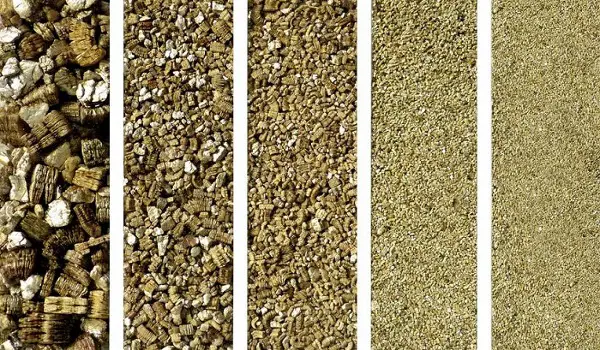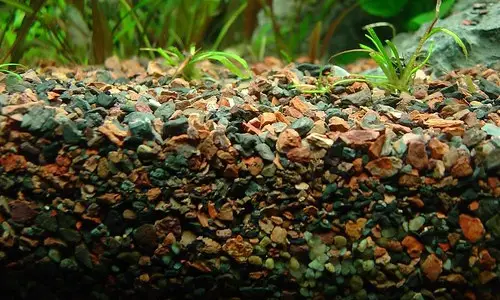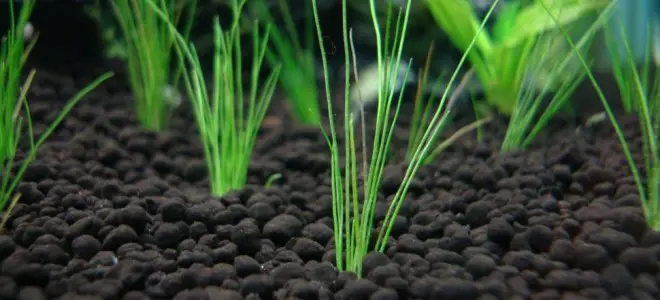An aquarium is a small ecosystem, the balance of which is extremely important to maintain for the well-being of all its inhabitants. One of the main roles in this process is played by aquarium substrate. The correct choice of substrate for aquarium plants is of great importance Here is our aquarium substrate guide.

Thanks to the flooring in the aquarium, you can get a beautiful view of the home pond.
Table of Contents
Aquarium Substrate For Different types of Aquarium
Substrate is essential in most types of aquariums. Aquarium plants take root in it, for which the soil serves as the main source of nutrients. The bottom litter is a habitat for some species of fish, molluscs and arthropods.
The soil in the aquarium acts as a powerful biofilter. Colonies of bacteria settle in it, processing organic waste and turning them into harmless compounds. The composition of the water and the well-being of the inhabitants of the aquarium depend on the state of the substrate.
The decorative role of the soil is also important. He is able to decorate any artificial reservoir and give it originality.
FRESHWATER FISH Substrate
The type of substrate used in a freshwater aquarium depends on their species, size, behavior and lifestyle. For example, goldfish love to dig and can capture particles during feeding; for them it is better to choose a large faction. Bottom inhabitants hide in the ground – the small fraction is suitable for them. Some fish species require a soft bottom cover to lay eggs in.
In terms of color, preference should be given to dark substrates. Against their background, the color of the inhabitants of the aquarium will be brighter.
SALT AQUARIUM Substrate
The soil in a marine aquarium is a habitat for invertebrates and fish, serves as a place for corals to anchor and maintains water parameters at the required level.
substrate For live plant aquarium
The substrate used in a live plant aquarium should be nutrient-rich. To do this, it is recommended to make it multilayer: place a special nutritious substrate under the main layer.
Such a structure of the substrate is needed so that it is easy for plants to root and nothing interferes with the development of the root system. It is generally recommended to use a medium-grained fraction with a particle diameter of 2-5 mm. For plants with long and powerful roots, a larger fraction is used.
The size of the fraction is also important because aerobic bacteria multiply in loose, well-washed and aerated soil, converting organic waste into useful substances for plants.
Small particles cover the bottom of the aquarium and prevent water from circulating. Anaerobic bacteria begin to multiply in the litter, which contribute to the decay of the substrate and the release of harmful substances into the water. Too large particles are bad because nutritious organic compounds are not retained between them: they are easily washed out by water and become inaccessible to plants.
Another important parameter when keeping plants is the height of the soil layer. Plants should be planted in a litter with a thickness of 5-7 cm or more; this way they can grow better.
Types of Aquarium Substrate
All existing substrates used in the aquarium hobby can be divided into 3 groups:
- natural (quartz, pebbles, gravel, sand, lava);
- processed (fired clay, expanded clay);
- artificial (plastics, glass).

In addition, a distinction is made between neutral and nutritious types of soil. Neutral litters do not contain substances beneficial to plants; a sufficient amount of organic matter accumulates in them only a few months after launch. Nutrient mixtures are used in herbal aquariums and serve, depending on the composition of the fertilizer, as a source of micro- or macroelements.
REFINED SAND
Sand is one of the widely used natural neutral types of bottom cover. Preference should be given to river sand, because the sea is usually shallower, cakes and does not allow water to pass through. For better aeration of the litter, it is recommended to choose sand with a particle size of at least 1.5-3 mm. To increase the aeration of the soil, sand of different fractions should be poured in layers: a larger one on top of a smaller one.
In terms of color, preference should be given to dark or gray sand. Light-colored sand reflects light, which causes stress in fish. Sand of a red or yellow color cannot be used, because this color is due to the content of iron oxides in it, which are harmful to the inhabitants of the aquarium.
ARAGONITE FOR THE MARINE ECOSYSTEM
Aragonite is a natural substrate formed by fragments of coral and mollusk shells. It comes in various factions; the most commonly used sand with a particle diameter of 0.2 to 2 mm.
Aragonite substrate is produced by the deposition of small coral debris.
The main property of aragonite is to maintain water hardness. When the pH drops below 8.2 (the pH of natural seawater), it begins to dissolve, releasing calcium and other elements, and thus alkalizes the environment.
Aragonite sand has a porous structure and low weight. Thanks to these properties, it cakes less and prevents the soil from souring. Colonies of beneficial bacteria develop in the pores of the substrate.
Live aragonite is often used for marine aquariums. It is collected from the seabed in places of mass concentration, packed in bags without preliminary treatment with a small amount of water.
Such a bottom cover contains colonies of natural microorganisms, which contributes to a more rapid establishment of bioequilibrium in an artificial reservoir.
REGULAR GRAVEL
Gravel is a widely used natural soil. It is chemically inert and does not change water parameters, it lacks nutrients.
Gravel particle sizes usually range from 3-5 mm. They must be smooth and free of sharp edges that could injure the fish. In addition, the rounded gravel cakes less and is better washed with water, which prevents it from acidification.
When choosing the color of gravel, red and yellow substrates should be avoided: they contain iron oxides that are harmful to the inhabitants of the aquarium.
The presence of shiny inclusions indicates the presence of heavy metals in the stones. Light-colored soil becomes polluted faster and becomes overgrown with algae. Therefore, it is preferable to use gravel of dark and gray shades.
NUTRITIOUS VERMICULITE
Vermiculite is a mineral from the hydromica group with a layered structure. When treated with high temperatures, it swells. This process is due to the presence of water in its structure, which, when heated, turns into steam and expands.
Expanded vermiculite is capable of absorbing water in volumes 5 times its own weight. In aquariums, expanded vermiculite is used in combination with other nutrient bedding or in pure form.
Vermiculite is added to nutritional mixtures as a sorbent. This mineral swells in water.
Due to its loose structure, it allows you to achieve good washing of the soil with water and does not allow it to sour; plant roots in vermiculite are well aerated.
The porous structure of vermiculite helps retain nutrients in the litter and keeps them from dissolving.
Vermiculite contains iron, magnesium, potassium, calcium and other minerals actively used by plants. In the pores of the material, aerobic microorganisms multiply and form colonies. Thanks to these qualities, vermiculite for plants can be used in its pure form.
Expanded vermiculite can be of different fractions.
SHATTERED CORALS
Coral fragments of various fractions are often used as substrates for marine aquariums and cichlids. where hard water is required. Coral skeletons are rich in calcium, which is released into the water when the pH drops to 8.2.
In addition, corals have a porous structure, due to which a large number of beneficial microorganisms are able to settle in them. The soil is well aerated, does not cake and does not sour.
One of the most commonly used coral substrates is coral sand. It is harvested from the seabed near coral reefs and dried at low temperatures. At the same time, parasites and pathogens of fish diseases die, and beneficial bacteria remain. Thanks to this, the laying of such a soil in the aquarium allows you to quickly create bio-equilibrium.
In addition to dried coral sand, live coral sand can be used in saltwater aquariums. After extraction, it is packaged wet with seawater. At the same time, living natural invertebrates and microorganisms are preserved in it. Placing such soil in the aquarium allows you to quickly achieve the required water parameters.
Coral sand for an aquarium made from skeletons of living organisms increases the rigidity of the environment.
ANCIENT LATERITE
Laterite is clay and rock debris from tropical and subtropical zones that has been exposed to sun and rain for thousands of years and is rich in iron. In reservoirs with plants, laterite is used as a nutritious bedding. It is placed on the bottom and covered with gravel on top. It is important that the laterite does not come into contact with water, otherwise the iron will be released and poison the aquarium inhabitants.
What type of Aquarium substrate should you avoid?
Some types of soil on the market are strongly discouraged for use in an aquarium.

GLASS SOIL
Glass products have a smooth surface, devoid of pores, which prevents bacteria from multiplying on them. The nutrients necessary for plants are not retained between the large glass balls. Leaching into the water, organic matter poisons the fish.
LAYERED SOIL
When filling the soil in layers (on top of a larger fraction – a smaller one), the looseness of the substrate is lost. It clots, aerobic bacteria die.
Organic waste begins to rot, poisoning the water. Due to the intake of organic matter, algae grow rapidly in the water column.
The flaky soil cakes and the water in the aquarium turns into a swamp.
EXPANDED CLAY
Expanded clay is not recommended for use in aquariums due to its too high porosity. It is able to accumulate a large amount of organic matter and abruptly throw harmful substances back into the water. Expanded clay is light, so when fish dig it, a lot of mud and silt rises.
GARDEN LAND
Garden land is rich in organic matter. When it enters the aquarium, rotting processes begin, leading to poisoning and death of fish. In addition, the soil contains many microorganisms that can cause disease in the aquarium dwellers.
DIY Aquarium Substrate By hands
You can prepare your own nutrient mixture for aquarium plants.

For this you will need:
- Charcoal (activated in granules or natural birch). It absorbs harmful substances from the soil, cleaning the litter.
- Clay is a source of minerals necessary for the life of plants.
- Sorbent (vermiculite) is an active additive that retains nutrients in the soil and does not allow them to dissolve in water.
- Peat (pressed or in granules) is a source of organic matter required for plant nutrition. In its natural form, it can cause soil acidification.
- Finely chopped fallen leaves and coconut fiber are also sources of beneficial organic matter. Some tree species decompose too quickly or too slowly, so coconut fiber is preferred. The release of nutrient compounds from coconut fiber occurs evenly and continuously.
- Coarse sand or small pebbles.
How to calculate amount of Aquarium Substrate?
To calculate how much litter you need for your aquarium, you can use the formula:
m = h * b * a * 1.5 / 1000,
where m is the mass of the substrate in kg,
h is the height of its layer in cm,
b – the width of the aquarium,
a is its length.
If few plants are planned in the aquarium, the soil layer can be about 2-3 cm. In specialized herbal aquariums, a layer of bottom litter with a thickness of 5-7 cm or more is needed.
Correct Placement of Aquarium Substrate in Fish Tank
The nutrient mixture for plants (purchased or prepared independently) is placed on the bottom; the thickness of the layer should be about 2-3 cm. If the plants are planted in groups in separate areas, then the nutrient substrate is placed only on these areas. A basic neutral soil with large or medium-sized particles is placed on top of the substrate. This is necessary so that the nutritious bedding is not washed out with water; in addition, plant roots are strengthened in the upper layer.
The soil in the aquarium can be spread evenly over the bottom or sloped towards the front glass. In this case, the thickness of the litter at the rear wall can reach 8 cm, at the front – 2-3 cm. It is recommended to make a depression in the center, in which waste will accumulate. This arrangement makes it easier to clean the aquarium.
The area of the bottom under the stern point should be left without soil or laid in a thin layer. A shallow cuvette or saucer can be placed in this location. This will make it easier for the fish to pick up dropped food.
Before placing the soil in the aquarium, it is necessary to free it from dust by rinsing in water, and, if necessary, to boil and ignite for disinfection. Nutrient substrates and fertilizers cannot be washed and calcined, otherwise useful substances and microorganisms will be lost.
If the aquarium is planned for inhabitants that require soft water, the soil should be checked for limestone content before laying.
For this, acetic acid is applied to the litter particles. The appearance of hissing gas bubbles indicates the presence of carbonates and bicarbonates in the material, which, when released into water, will dissolve and raise the pH.
How to clean Aquarium Substrate?
Large amounts of organic waste accumulate in the aquarium bedding over time. They begin to decompose and release into the water substances that poison fish and provoke the growth of algae. As a result, the water becomes cloudy and begins to smell unpleasant.
To avoid these problems, the soil should be cleaned regularly. The most convenient way to do this is with a siphon.
how to properly clean aquarium gravel with Siphon?
The siphon is an ordinary hose with a funnel at the end. The funnel is lowered to the ground level and sludge is collected from its surface. To start the operation of the siphon, a vacuum must be created in the hose, under the action of which the dirty water will flow from the aquarium into the substituted container.
When cleaning the soil with a siphon, it is necessary to monitor the water level in the aquarium. At one time, it is allowed to drain no more than 25% of the total volume.
Advatages of aquarium siphon gravel cleaner
When cleaning the soil with a siphon, there is no need to evict the inhabitants of the aquarium and remove the plants.
The siphon does not collect all the sludge, therefore, after cleaning, a certain amount of organic matter is always retained in the soil for plant nutrition. This is the advantage of siphon cleaning over full rinsing and substrate replacement.
The disadvantages of this cleaning method include the possibility of small fish and molluscs getting into the hose, clogging of the hose with soil particles, and the likelihood of draining too much water, which will lead to a shift in its parameters and disruption of bio-equilibrium in the aquarium. In addition, the siphon lifts a large amount of organic matter from the bottom, which can provoke the reproduction of algae and water bloom.
When you should not use clean aquarium gravel with Siphon
The aquarium soil should not be cleaned within the first year after start-up. at this time, there is an active accumulation of nutrients and beneficial bacteria in the amount necessary for plants. In order to avoid the loss of the nutrient substrate in herbal aquariums, the soil is siphoned only in open areas.